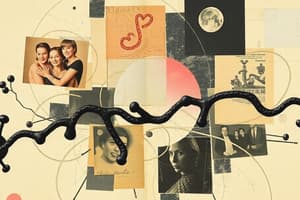Podcast
Questions and Answers
Where does translation take place?
Where does translation take place?
- Nucleus
- Ribosome (correct)
- Endoplasmic reticulum
- Golgi apparatus
Which nucleic acid is translated to make a protein?
Which nucleic acid is translated to make a protein?
- mRNA (correct)
- tRNA
- DNA
- rRNA
Which of the following processes is an example of a post-translational modification?
Which of the following processes is an example of a post-translational modification?
- Phosphorylation (correct)
- Initiation
- Elongation
- Peptide bond formation
Which of the following steps occurs last in the initiation phase of translation?
Which of the following steps occurs last in the initiation phase of translation?
At which site do new aminoacyl tRNAs enter the ribosome during elongation?
At which site do new aminoacyl tRNAs enter the ribosome during elongation?
What is meant by translocation?
What is meant by translocation?
A tRNA with an anticodon complementary to the stop codon catalyzes the reaction by which translation is terminated.
A tRNA with an anticodon complementary to the stop codon catalyzes the reaction by which translation is terminated.
Which of these is a tRNA?
Which of these is a tRNA?
What enzyme catalyzes the attachment of an amino acid to tRNA?
What enzyme catalyzes the attachment of an amino acid to tRNA?
The tRNA anticodon, GAC, is complementary to the mRNA codon with the sequence ____.
The tRNA anticodon, GAC, is complementary to the mRNA codon with the sequence ____.
What is the name of the process shown in the diagram?
What is the name of the process shown in the diagram?
The initiator tRNA attaches at the ribosome's _____ site.
The initiator tRNA attaches at the ribosome's _____ site.
What is the process called that converts the genetic information stored in DNA to an RNA copy?
What is the process called that converts the genetic information stored in DNA to an RNA copy?
DNA does not store the information to synthesize which of the following?
DNA does not store the information to synthesize which of the following?
Transcription begins at a promoter. What is a promoter?
Transcription begins at a promoter. What is a promoter?
Which of the following statements best describes the promoter of a protein-coding gene?
Which of the following statements best describes the promoter of a protein-coding gene?
What determines which base is to be added to an RNA strand during transcription?
What determines which base is to be added to an RNA strand during transcription?
Which of the following terms best describes the relationship between the newly synthesized RNA molecule and the DNA template strand?
Which of the following terms best describes the relationship between the newly synthesized RNA molecule and the DNA template strand?
What happens to RNA polymerase II after it has completed transcription of a gene?
What happens to RNA polymerase II after it has completed transcription of a gene?
Flashcards are hidden until you start studying
Study Notes
Translation Process
- Translation occurs at the ribosome, the site essential for protein synthesis.
- The nucleic acid mRNA is translated to form proteins, guiding the assembly of amino acids.
Post-Translational Modifications
- Phosphorylation is a key example of post-translational modification that modifies protein function.
Initiation Phase of Translation
- In the initiation phase, the large ribosomal subunit is the last component to join the translation complex.
- New aminoacyl tRNAs enter the ribosome at the A-site during the elongation phase.
Key Concepts in Translation
- Translocation refers to the movement of the ribosome along the mRNA, shifting by one codon.
- True termination of translation does not involve a tRNA anticodon binding to the stop codon.
tRNA and Codons
- tRNA molecules match their anticodons to complementary mRNA codons, exemplified by the GAC tRNA pairing with the CUG codon.
- Aminoacyl-tRNA synthetase is the enzyme responsible for attaching amino acids to their corresponding tRNAs.
Process of Transcription
- Transcription, the conversion of DNA genetic information into RNA, begins at a specific region known as the promoter.
- The promoter is located in the DNA and serves as a recruitment site for RNA polymerase to initiate transcription.
Characteristics of Promoters
- Promoters are nontranscribed regions of genes, crucial for regulating gene expression.
- The correct base is added to the RNA strand during transcription based on base pairing with the DNA template strand.
Relationship Between RNA and DNA
- The synthesized RNA strand is complementary to the DNA template strand, ensuring accurate information transfer.
- Upon completion of transcription, RNA polymerase II becomes free to initiate transcription of other genes.
Additional Notes
- DNA does not encode information for organelles, focusing instead on proteins and RNA synthesis.
Studying That Suits You
Use AI to generate personalized quizzes and flashcards to suit your learning preferences.




